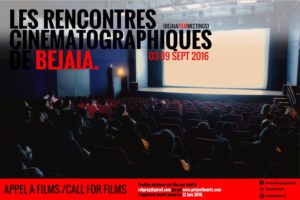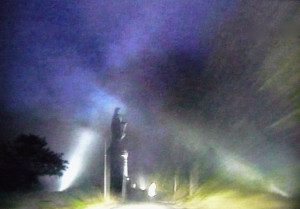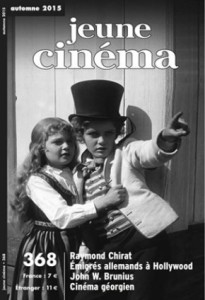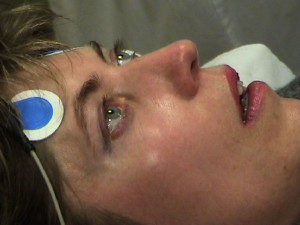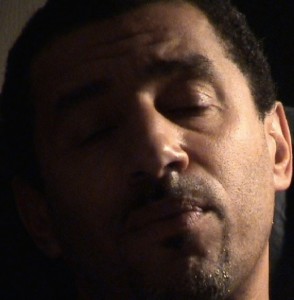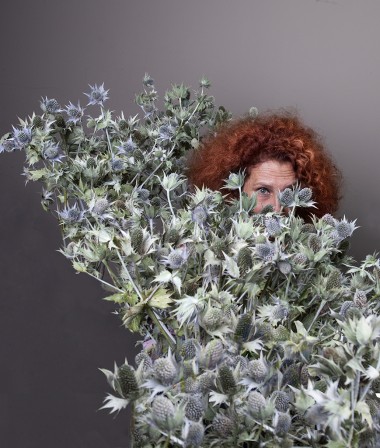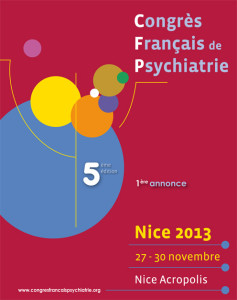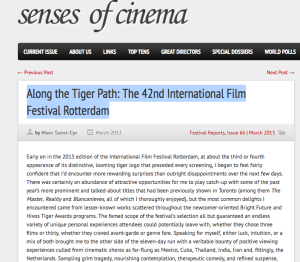- Nouvelles du Front Cinématographique – Un article de Saad Chakali – Octobre 2018 – Quelques éclairs tombés sur Béjaïa
- Uzac – Rivista on line di cultura cinematografica – Un article de Mariangela Sansone – Mai 2017
- Ardigiland – Blog Italien – Décembre 2016 – Un entretien avec Silvia Tarquini
- Le Journal Algérien L’EXPRESSION – Septembre 2016 – Un article de Hind Oufriha
D’une durée de presque quatre heures, ce documentaire projeté en deux parties aux Rencontres cinématographiques de Béjaïa, lundi dernier, est sans aucun doute notre coup de coeur cette année.«Cette fresque est un cinéma en zigzag, à l’image des ramifications de l’éclair. Il décline son sujet dans plusieurs pays du monde et sur plusieurs siècles, simultanément, sous une forme documentaire et légendaire.» Ceci est le synopsis de cette expérience auditive, plastique des plus fantastiques.
Pour celui qui veut retrouver ses énergies perdues, ne serait-ce que symboliquement, il doit voir ce fabuleux documentaire scindé en quatre parties, à savoir Foudre, une légende en quatre saisons car il est primordial, voire nécessaire, comme pour nous, qui l’avions vu, cette année aux 14es Rencontres cinématographiques de Béjaïa. Un véritable coup de coeur dont la réalisatrice nous dévoile quelques bouts des secrets de cet objet filmique des plus rares et des plus magnifiques surtout en se confiant à L’Expression…
- Le Soir d’Algérie – Septembre 2016 – Un article de Sarah Haidar
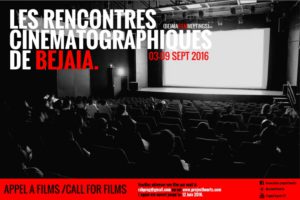 Un film-documentaire de presque quatre heures a été projeté lundi aux 14es Rencontres cinématographiques de Béjaïa. Ecrit et réalisé par Manuela Morgaine, Foudre, une légende en quatre saisons, a mis dix ans pour voir le jour et, au fil de la projection, l’on comprend pourquoi : le temps n’a plus aucune importance !
Un film-documentaire de presque quatre heures a été projeté lundi aux 14es Rencontres cinématographiques de Béjaïa. Ecrit et réalisé par Manuela Morgaine, Foudre, une légende en quatre saisons, a mis dix ans pour voir le jour et, au fil de la projection, l’on comprend pourquoi : le temps n’a plus aucune importance !
- Plateforme de cinéma QUIET EART Avril 2016 – Un article de Manuel de Layet
It’s not often that a picture actually does rattle me to my core, genuinely fucks me up. Last time it happened was with Joshua Oppenheimer’s The Look of Silence.This one is also a documentary, proving the effectiveness of the « cinéma du réel » and let me stress the word effectiveness: Forty eight hours in I’m still vaguely queasy and cannot wait to finish this piece so I can stop having to analyse the experience. Said experience being called Lightning: A Legend in Four Seasons and about lightning strikes, one must wonder why the result of seeing it is me wanting to curl up under a piece of furniture and die.
- Revue Le Jeune Cinéma Janvier 2016 – Un article d’Annie Vignaux-Laurent
- Revue Le Jeune cinéma Décembre 2015 – Signature des coffrets dvds de FOUDRE à la Librairie du Cinéma du Panthéon
- Blog de Francesco Cazzin – Juin 2015 – L’emergere del possibile – (en italien – traduction française et anglaise en cours)
- Culturopoing Mai 2015 – Article de Sophie Yavari à l’occasion de la sortie du coffret DVD de FOUDRE avec Shellac
- Edi Psy Février 2015 – le Docteur William de Carvalho (incarnant le personnage de Saturne) nous parle de son expérience de FOUDRE
- Thierry Lavergne – Mars 2015 – Article sur le site de Psy Cause
- Silvia Tarquini – Novembre 2014 – Article sur le blog Artdigiland
- Sanjay Wadhwa – Festival Report – MARS 2014 – Article dans la revue Deep focus Cinema
Prajakta Hebbar – 15 janvier 2014 – Article dans le quotidien Indian Express
- Thierry Jolif – Novembre 2013 Article et entretien paru dans Unidivers.fr
- AFRICINE présente FOUDRE sur son site, la saison d’hiver du film se déroulant en Guinée-Bissau. Pour voir la présentation cliquez ici ou sur l’icône
- Natalia Kaniak – Juillet 2013 – Interview de Manuela Morgaine dans le cadre de la 13ème édition du prestigieux festival de cinéma t-mobile new horizons en Pologne
Traduction de l’article en français cliquez ici
-
Alexey Artamonov – juin 2013 – Theory& Practice ( en français grâce à Pierre Léon en suivant le lien )
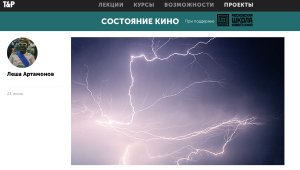
- Margot Morgiève – Juin 2013 – Newsletter du Congrès français de psychiatrie
- Dmitry Volchek – Février 2013 – sur Svoboda
- Culturopoing May 2015 – Sophie Yavari’s article about the edition of the coffret box of LIGHTNING with Shellac

- Edi Psy – February 2015 – Dr William de Carvalho ( Saturn’s character in the movie) tells us about his experience of LIGHTNING.
- Thierry Lavergne – March 2015 – Article on the website of Psy Cause
- Silvia Tarquini – November 2014 – Article on the blog Artdigiland
- Sanjay Wadhwa – Festival Report – MARCH 2014 – Article in the review Deep focus Cinema
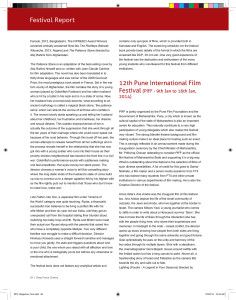
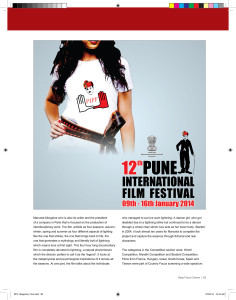 Prajakta Hebbar – January 15th 2014 – Article in the daily Indian Express
Prajakta Hebbar – January 15th 2014 – Article in the daily Indian Express
- Thierry Jolif – November 2013, Article and interview published in Unidivers.fr (French). English translation here.

- AFRICINE presents LIGTHNING on it’s website, the winter season of the movie was shot in Guinee Bissau. To see the presentation click here or on the picture
- Interview with Manuela Morgaine by Natalia Kaniak of the 13th annual edition of the prestigious T-Mobile film festival “New Horizons” in Poland – July 2013
- English translation of the article by Magda Sztorc click here
Follow the link or click on the picture
- Alexey Artamonov – June 2013 – Theory& Practice (English translation by David H. Pickering of the French translation by Pierre Léon available here)
- Margot Morgiève – June 2013 – Newsletter du Congrès français de psychiatrie (in French, English translation below):
Struck by Lightning: An Electric Legend
Neither documentary nor fiction, “Lightning” is an astonishing film, a liminal object which tells fragments of the stories of five lightning-strike victims and five melancholic patients. These stories unfold with a simple, honest beauty. Manuela Morgaine recorded their testimonials for nine years, and then asked them to return to the places where they were struck by lightning, or to occupy the places that symbolize their angst. These true stories take on the substance of legend.
Rare footage of current electroconvulsive therapy methods (ECT) and archival video footage of lightning coalesce into dreamlike stories.
At the same time, the lightning-hunter embodies Baal, the Syrian god of lightning. The psychiatrist who practices electroconvulsive therapy is also the god and planet Saturn. He appears in a loincloth, lying at the bottom of a dugout canoe, as he floats down a river in Guinea-Bissau on the trail of traditional practices.
We catch up with him in his clinic –which is built on the ruins of a “madness” frequented by the Marquise de Pompadour – with his melancholic patients and then with dancers who hold the secret of healing. The characters evolve at a unique pace, which is broken down into the four seasons.
Their stories reverberate and echo each other, somewhere between documentary and mythology.
- Marc Saint Cyr- Mach 2013 – Senses of cinema
- Rotterdam : Come Crashing Down By Boris Nelepo (March 2013) – –Fipresci
- Dmitry Volchek – February 2013 – sur Svoboda
